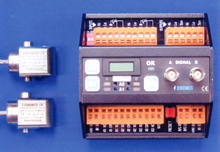Effective ‘SIL’ Vibration Monitoring
PRODUCT PRESS RELEASE
7th July 2010
For Immediate Release
REDUCING RISK WITH EFFECTIVE ‘SIL’ VIBRATION MONITORING
Monitoring vibration on critical rotating plant can play a key role in meeting the protection requirements of the latest machinery directives, specifically (Directive 2006/42/EC) which came into force at the end of 2009. This directive demands that machine manufacturers identify the hazards and risks their products present to users. Any risks identified must be reduced to as low a level as is reasonably practicable. The important considerations are; failure of rotating plant can not only be expensive in terms of repair cost and lost revenue through downtime, but also pose a significant health and safety risk. Also, what level of integrity does a vibration protection system need to ensure safe shutdown under all operational conditions?
To help manufacturers and operators meet these latest protection requirements and to minimise the risks, condition monitoring specialists SENSONICS have developed proven and robust vibration protection systems for many industrial sectors. For example their DN2611 SIL (Safety Integrity Level) rated dual channel monitor is ideal for machine casing and bearing vibration monitoring applications. It provides dual level alarms (warning and danger) for each channel and provides a relay interface for plant shutdown and health monitoring.
The IEC61508 international standard for functional safety can be applied in conjunction with the directive to ensure that sufficient integrity is designed in to the electrical / electronic systems employed for this function. The methodology starts with the appropriate SIL required for the process and with a proposed protection system in place, a failure mode and effects analysis is carried out on the overall control loop, from sensor to shutdown actuator. This determines not only the MTBF of the equipment but also the diagnostic coverage and the safe failure fraction. These factors in combination with protection system redundancy are used to calculate the overall SIL level.
Current loop outputs for each channel are provided for interfacing with a PLC for trending and further alarm monitoring. The transducer interface can be configured for operation with or without safety barriers. In a simplex configuration the monitor used in conjunction with Sensonics PZS4 accelerometer is suitable for SIL 1 applications, while in a duplex configuration (2 parallel channels) protection can be provided at a SIL 2 level. Where the probability of failure to trip on demand for each configuration is designed to meet SIL target, the resulting spurious trip performance is also excellent. This ensures a high integrity protection solution with minimal risk of downtime due to spurious events. ENDS.
Further details are available from: Jason Kingdom, Sensonics Ltd, Berkhamsted, Hertfordshire, UK.
Tel: +44 (0) 1442 876833. Fax: +44 (0) 1442 876477
Email: sales@sensonics.co.uk www.sensonics.co.uk
Product Press Release issued for Sensonics Ltd by:
Andrew Harvey – Harvey Communications
Tel: +44 (0) 1342 714447 Fax: +44 (0) 1342 713233
Email: admin@harveycomms.co.uk www.harveycomms.co.uk
DN2611PR0710.doc

